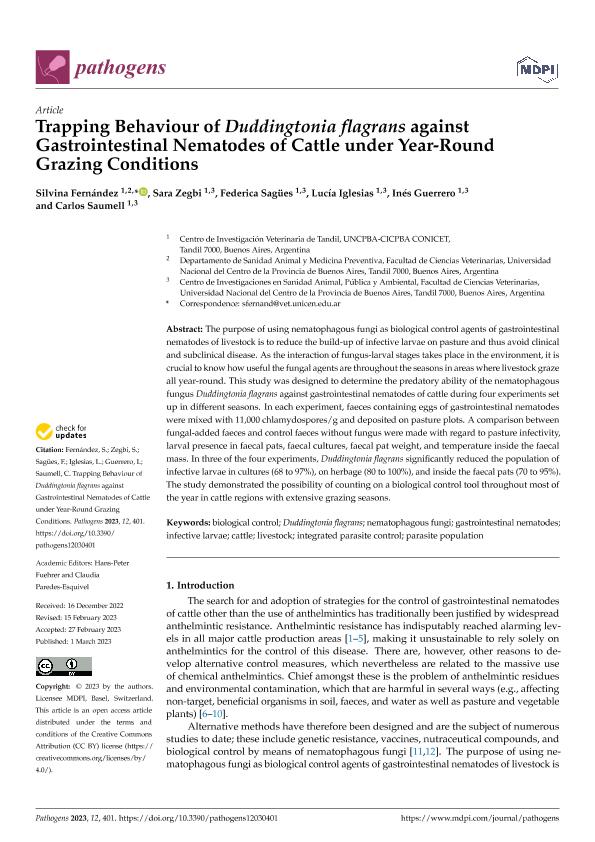Artículo
Trapping behaviour of Duddingtonia flagrans against gastrointestinal nematodes of cattle under year-round grazing conditions
Fernández, Alicia Silvina ; Zegbi, Sara
; Zegbi, Sara ; Sagüés, María Federica
; Sagüés, María Federica ; Iglesias, Lucía Emilia; Guerrero, Ines; Saumell, Carlos Alfredo
; Iglesias, Lucía Emilia; Guerrero, Ines; Saumell, Carlos Alfredo
 ; Zegbi, Sara
; Zegbi, Sara ; Sagüés, María Federica
; Sagüés, María Federica ; Iglesias, Lucía Emilia; Guerrero, Ines; Saumell, Carlos Alfredo
; Iglesias, Lucía Emilia; Guerrero, Ines; Saumell, Carlos Alfredo
Fecha de publicación:
03/2023
Editorial:
Multidisciplinary Digital Publishing Institute
Revista:
Pathogens
ISSN:
2076-0817
Idioma:
Inglés
Tipo de recurso:
Artículo publicado
Clasificación temática:
Resumen
The purpose of using nematophagous fungi as biological control agents of gastrointestinal nematodes of livestock is to reduce the build-up of infective larvae on pasture and thus avoid clinical and subclinical disease. As the interaction of fungus-larval stages takes place in the environment, it is crucial to know how useful the fungal agents are throughout the seasons in areas where livestock graze all year-round. This study was designed to determine the predatory ability of the nematophagous fungus Duddingtonia flagrans against gastrointestinal nematodes of cattle during four experiments set up in different seasons. In each experiment, faeces containing eggs of gastrointestinal nematodes were mixed with 11,000 chlamydospores/g and deposited on pasture plots. A comparison between fungal-added faeces and control faeces without fungus were made with regard to pasture infectivity, larval presence in faecal pats, faecal cultures, faecal pat weight, and temperature inside the faecal mass. In three of the four experiments, Duddingtonia flagrans significantly reduced the population of infective larvae in cultures (68 to 97%), on herbage (80 to 100%), and inside the faecal pats (70 to 95%). The study demonstrated the possibility of counting on a biological control tool throughout most of the year in cattle regions with extensive grazing seasons.
Archivos asociados
Licencia
Identificadores
Colecciones
Articulos(CIVETAN)
Articulos de CENTRO DE INVESTIGACION VETERINARIA DE TANDIL
Articulos de CENTRO DE INVESTIGACION VETERINARIA DE TANDIL
Citación
Fernández, Alicia Silvina; Zegbi, Sara; Sagüés, María Federica; Iglesias, Lucía Emilia; Guerrero, Ines; et al.; Trapping behaviour of Duddingtonia flagrans against gastrointestinal nematodes of cattle under year-round grazing conditions; Multidisciplinary Digital Publishing Institute; Pathogens; 12; 3; 3-2023; 1-12
Compartir
Altmétricas



